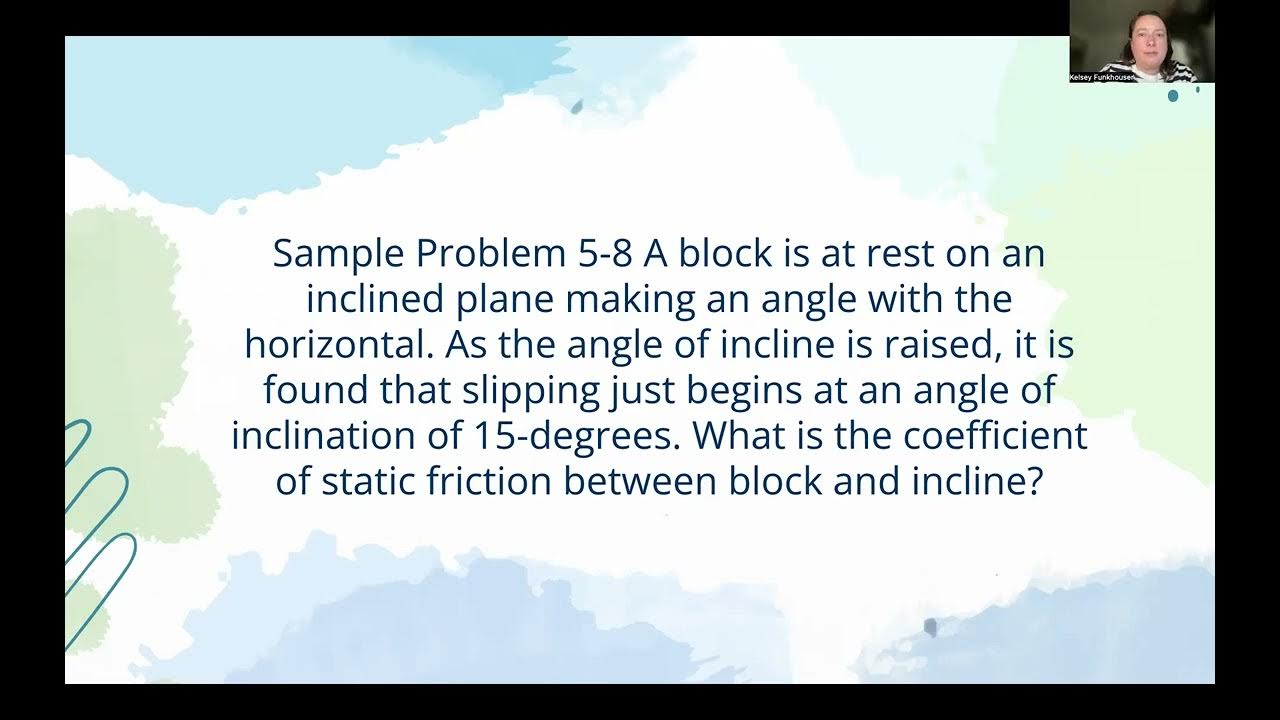Fuerza de fricción o rozamiento
Summary
TLDRIn this video, the concept of friction is explored, focusing on how it interacts with Newton's Laws of Motion. The speaker discusses both static and kinetic friction, explaining how friction opposes motion and how it can be calculated using specific formulas. Static friction prevents an object from moving until enough force is applied to overcome it, while kinetic friction occurs once movement starts. The video highlights the importance of understanding the different coefficients of friction and demonstrates how to apply them in real-world scenarios and exercises, providing a valuable introduction to the topic of friction in physics.
Takeaways
- 😀 Friction is present in our daily lives and always acts against the motion of objects.
- 😀 The video discusses how friction is involved in Newton's laws, which often neglect friction for simplicity.
- 😀 Static friction occurs when an object is at rest, and a force is applied to move it.
- 😀 Kinetic friction is the frictional force that opposes the motion of an object already in motion.
- 😀 To calculate static friction, we use the formula: F_static = μ_s × F_normal, where μ_s is the coefficient of static friction.
- 😀 The coefficient of friction depends on the materials in contact, such as wood, ice, steel, etc.
- 😀 The normal force, F_normal, is usually equal to the object's weight when on a horizontal surface.
- 😀 If the applied force is greater than the static friction, the object begins to move, and friction becomes kinetic.
- 😀 Kinetic friction is calculated similarly to static friction, with the formula: F_kinetic = μ_k × F_normal, where μ_k is the coefficient of kinetic friction.
- 😀 Differentiating between static and kinetic friction is important when solving real-world physics problems involving motion.
- 😀 In future videos, more exercises will be shown to help viewers apply these concepts of friction in practical situations.
Q & A
What is the primary focus of this video?
-The video focuses on explaining the concept of friction, specifically static and kinetic friction, within the context of Newton's laws of motion.
Why is friction important in real life according to the video?
-Friction is important because it is always present in real-life situations. Unlike idealized physics problems where surfaces are assumed to be frictionless, friction affects almost every movement we make, such as when moving objects like furniture.
What is static friction and how is it calculated?
-Static friction is the force that resists the initiation of movement when an object is at rest. It is calculated using the formula: F_friction_static = μ_s * F_normal, where μ_s is the static friction coefficient, and F_normal is the normal force, typically equal to the object's weight.
What happens when you exceed the force of static friction?
-When the applied force exceeds the static friction force, the object starts to move, and the frictional force transitions from static to kinetic friction.
What is kinetic friction and how is it different from static friction?
-Kinetic friction is the force that opposes the motion of an object once it has started moving. It is different from static friction in that it occurs during motion, while static friction only occurs when the object is at rest.
What is the formula for kinetic friction?
-The formula for kinetic friction is: F_friction_kinetic = μ_k * F_normal, where μ_k is the coefficient of kinetic friction and F_normal is the normal force.
How do you determine which friction coefficient (static or kinetic) to use in a problem?
-You use the static friction coefficient when the object is at rest and you're trying to initiate movement. Once the object starts moving, you switch to the kinetic friction coefficient.
What factors influence the magnitude of friction between two surfaces?
-The magnitude of friction is influenced by the roughness of the surfaces in contact and the normal force acting between them. The friction coefficient (either static or kinetic) also plays a significant role.
How does the surface roughness affect friction?
-Surface roughness creates microscopic peaks and valleys that cause resistance when two surfaces try to slide against each other. These irregularities are what we overcome when applying force to move an object.
What is the relationship between mass and friction in the context of this video?
-The mass of the object directly affects the normal force, which in turn influences the friction force. A heavier object will generally have a greater frictional force due to its larger normal force, requiring more effort to move.
Outlines

This section is available to paid users only. Please upgrade to access this part.
Upgrade NowMindmap

This section is available to paid users only. Please upgrade to access this part.
Upgrade NowKeywords

This section is available to paid users only. Please upgrade to access this part.
Upgrade NowHighlights

This section is available to paid users only. Please upgrade to access this part.
Upgrade NowTranscripts

This section is available to paid users only. Please upgrade to access this part.
Upgrade NowBrowse More Related Video

PHYS 121 - Week 4 Lecture 2 - Friction & Circular Motion

Gerak dan Gaya Kelas 7 - Gaya dan Hukum Newton | IPA Bab 4 Kurikulum Merdeka - Lengkap

BAB 4 GERAK DAN GAYA || Gaya dan Hukum Newton – IPA Kelas 7 Kurikulum Merdeka

Newton's Laws and Mousetrap Cars

Fisika Kelas 10 | Jenis - jenis gaya pada hukum Newton | Hukum Newton part 2

Balanced & Unbalanced Forces | Forces & Motion | Physics | FuseSchool
5.0 / 5 (0 votes)